
Yellow sponge on Osprey Reef.
There are quite a few organisms available in aquarium stores that are either unsuitable for aquaria or require a lot of effort to keep. This article discusses organisms that should be avoided and the reasons why they should be avoided. It also includes some organisms which require special conditions and this should be taken into consideration before acquiring them.
Please note, this article should not take place of the recommendation to research ALL potential inhabitants before getting them. If an organism is not listed below it does not mean that that organism does not have specific requirements.
While some sponges appear to do well in captivity, others don't and so it is best to avoid purchasing sponges. They are generally difficult to identify and there is little information about their requirements.

Yellow sponge on Osprey Reef.
Avoid purchasing live rock or corals with the symbiotic hydroid Myrionema as this hydroid can spread rapidly through the tank and is almost impossible to remove.

Myrionema sp.
This family contains some of the most beautiful soft corals, but unfortunately the beautiful ones are virtually impossible to maintain. The genera Stereonephthya, Scleronephthya, Dendronephthya, Umbellulifera and Leptophyton do not have symbiotic zooxanthellae and must rely on capturing all their food. Their survival rate in captivity is very poor and they should be avoided.

Dendronephthya sp. on the Great Barrier Reef.
Sea pens are difficult to keep and should only be attempted by experienced hobbyists.
Family Aiptasiidae - Glass Anemones
The glass anemones of the genus Aiptasia can become a pest in a reef aquarium. They reproduce rapidly by budding and pedal laceration (the anemone moves, leaving a small amount of tissue behind that can regenerate as a full anemone. Avoid purchasing live rock with Aiptasia attached and if you find any in your tank take quick action to remove them. They can be killed by injections of vinegar, calcium hydroxide paste, hydrochloric acid and Joe's Juice. Severe infestations can be controlled by some butterflyfish such as copperbands, Chelmon rostratus, or Klein's, Chaetodon kleinii.

Glass anemone, Aiptasia sp. in an aquarium
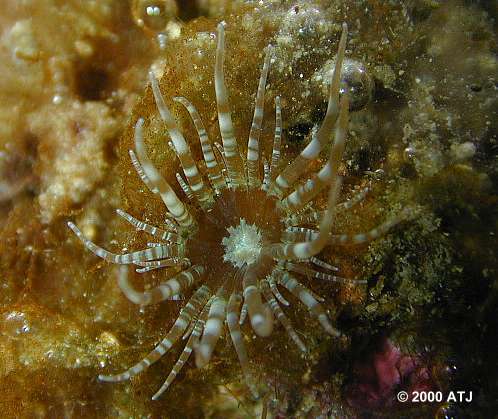
Glass anemone, Aiptasia sp. in an aquarium
Family Stichodactylidae - Host Sea Anemones
The host sea anemones live in a symbiotic relationship with anemonefish (and some damselfish). These anemonefish also host symbiotic algae in the same way that many corals do. While host anemones are not impossible to keep, they often don't do well in captivity. Many hobbyists claim these anemones require high intensity lighting, but for some species, their natural distribution does not suggest this. Heteractis magnifica and H. crispa can be found naturally in quite deep water - 20 m or more. Certainly, people that provide high intensity lighting appear to have more success. Host anemones are best left to experienced hobbyists. It is also worth noting that anemonefish will do fine in an aquarium without an anemone.

Heteractis crispa at a depth of 30.5 m on Osprey Reef.

H. magnifica at a depth of 20 m on the Great Barrier Reef.

Stichodactyla mertensii at a depth of 7 m on Osprey Reef.
Order Ceriantharia - Tube Anemones
Tube anemones require aquaria with very deep sand beds and should be avoided.
Species of the genus Goniopora have a very poor record in captivity. These are often sold as "golfball" or "flowerpot" corals. While there are some exceptions, most people find they die after 18 to 24 months in captivity, after initially appearing to do quite well. It is not known why they don't do very well when other stony corals seem to pose few problems. It is best to avoid Goniopora altogether. Note that a related genus, Alveopora, which is similar to Goniopora, also have a poor captivity record.

Goniopora sp. on Osprey Reef.

Fluorescent green Goniopora sp. on Osprey Reef.
For general information on polychaetes, see: The Worms Crawl In...
The Christmas tree worms of the genus Spirobranchus do not survive well in aquaria. Even if the required effort is put in, they are difficult to feed and usually die. They are best left in the ocean. For more information on these worms see: Christmas Tree Worms.
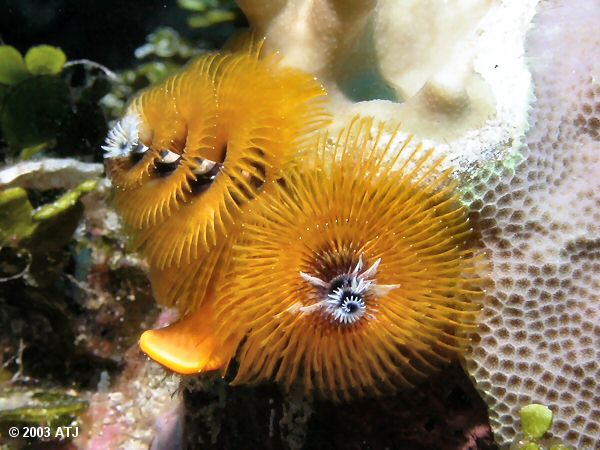
Christmas tree worm, Spirobranchus sp., on Osprey Reef.
Superfamiliy Cypraeacea - Cowries
Many cowries are carnivores and should be avoided. They mainly feed on sponges and corals (especially the egg cowries). Exceptions are Cypraea annulus, gold ringed cowrie, and C. moneta, money cowrie, which are both herbivores. The tiger cowrie, C. tigris may also be herbivorous.
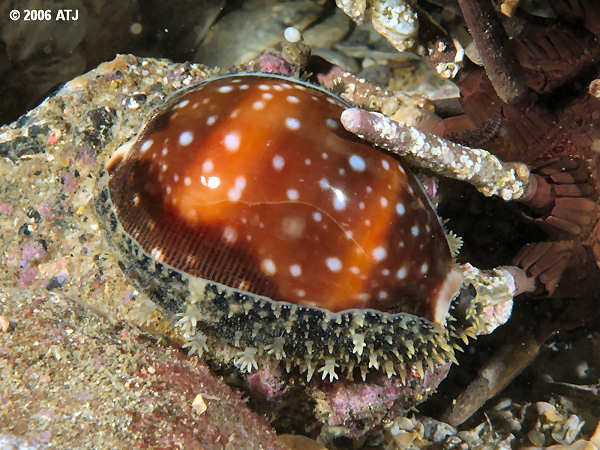
Milk spot cowrie, Cypraea vitellus, at Camp Cove, NSW.
Family Muricidae - Drill Shells
Murex shells are carnivores or scavengers. Many can bore into the shells of other molluscs, corals, echinoderms and even barnacles using their radula which has been modified into a sort of drill. As it is difficult to determine what eats what, these shells are best avoided. For more information, see: Digital Murex.
One particularly shell to avoid is Drupella as these are voracious predators on corals. They are responsible for doing a lot of damage to natural corals reefs so you can imagine what they could do in a captive reef.
Superfamily Conacea - Cone Shells and Allies
Cone shells are not only carnivores but most species can fire toxic darts to subdue their prey, for example, fish or other gastropods. Some species are highly toxic to humans. All cone shells should be avoided.

Geographic cone, Conus geographicus, at Osprey Reef. This particular species is one of the most deadly.
Order Nudibrancha - Nudibranchs
The word "nudibranch" translates to "naked gills" and the is the main characteristic of this group of organisms, although the classic circle of gills is only present on the hind end of the back of the dorids (Suborder Doridina). Nudibranchs are all carnivores and mainly feed on sponges, bryozoans, tunicates and corals. Some even feed on other gastropods. Due to their feeding requirements, they are difficult, if not impossible, to keep in captivity:
It is generally best to just avoid the temptation to buy any nudibranchs. For more information, see Naked ...Gills on Snails.

Glossodoris atromarginata in Sydney Harbour. This is a dorid and note the horns to the right and the circle of gills on the back to the left.
 Phyllidia varicosa on the Great Barrier Reef.
Phyllidia varicosa on the Great Barrier Reef.
Note that it is easy to confuse nudibranchs with sea hares. Sea hares are herbivores and make good additions to a tank. See The Sea Slug Forum for more information on nudibranchs and sea hares, including a list of species that can help in identification.
Family Octopodidae - Benthic Octopuses
Octopuses in general should be avoided unless a lot of research is carried out on their requirements and a special tank is set up. They are intelligent animals and can escape through the smallest gap - they are able to squeeze through a hole only slightly larger than their beak. A tank to house an octopus needs a very tight fitting lid, but also good oxygenation. For more information about octopuses and other cephalopods see: The Cephalopod Page.
The blue-ringed octopuses, Hapalochlaena spp., should be avoided most of all as their bite can be deadly.

Blue-lined octopus, Hapalochlaena fasciata, at Long Reef, New South Wales.
Echinoderms in general can be troublesome as they are not very tolerant of quick changes in salinity. Even if you are careful when you get a new echinoderm home and acclimate it slowly to the tank, you have no way of knowing if it was given the same treatment between collection and when you saw it in the aquarium store. There will always be a certain amount of risk in purchasing any echinoderm for this reason. Before buying any echinoderms, look closely at the animal and ensure that it is moving around. Any that sit in one place, unless on a food item, are probably displaying osmotic shock. This won't guarantee that the specimen is healthy, but it may help to detect unhealthy ones.
For general information on echinoderms see:
Class Crinoidea - Feather Stars
Feather stars (or crinoids) are suspension feeders. They spend the daylight hours hidden in holes and crevices but come out at night to feed. They perch on top of corals and other higher areas with their arms stretched out to capture matter suspended in the water. It is not know exactly what they capture but it may be detritus. In captivity they usually starve to death.
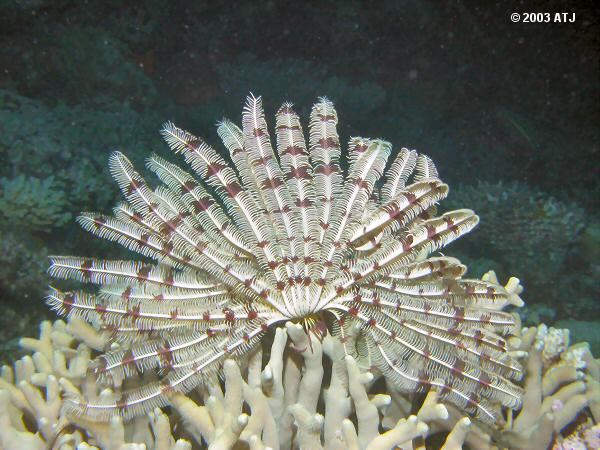
A crinoid feeding at night on Osprey Reef

A crinoid on Porites cylindrica on Osprey Reef
As most sea stars are carnivores, they are generally not suited for aquaria as they will either feed on hour prized inhabitants or they will starve to death.
For general information on the sea stars, see We Owe A Lot To Brainless Dominance. Starfish: Considerations for the Common (and Commonly Misunderstood) Varieties also contains some useful information on sea stars as well as ophiuroids.
The sea star Culcita novaeguineae is sometimes offered for sale under the name "pincushion starfish". These should be avoided as they feed on corals. In an aquarium without corals, they will starve. If there are corals present, they will eat them.

Culcita novaeguineae on the Great Barrier Reef
Sea stars of the genus Fromia are often available for purchase in aquarium stores. While some hobbyist books claim they feed on algae and detritus, it is not known what they really eat and sponges are more likely prey items. It should be noted that most sea stars are scavengers and carnivores (Ruppert and Barnes, 1994) and so very few, if any feed on algae. Most Fromia spp. sea stars slowly starve to death over the course of months.

Fromia indica on the Great Barrier Reef.
One species which may be successfully kept in an aquaria is Linckia laevigata, assuming it has been handled appropriately from collection to home aquarium. While it is not known on what they feed, it appears that a large established aquarium is able to provide sufficient food. Other species of Linckia as well as species of Leiaster may also survive in captivity. See: Sea Stars - Linckia spp..

Linckia laevigata on the Great Barrier Reef
Most ophiuroids are suitable for aquaria, with the obvious exception of basket stars which are filter feeders.
Family Gorgonocephalidae - Basket Stars
Basket stars are suspension feeders like crinoids and should not be attempted.
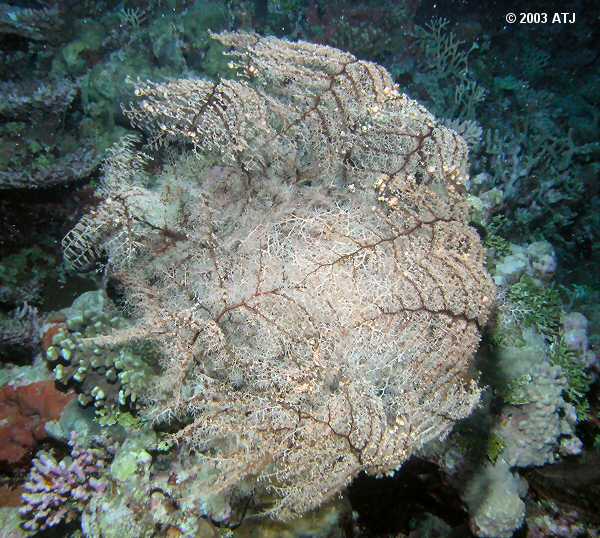
Basket star, Astoboa nuda, on Osprey Reef.
One possible exception in the ophiuroids are the serpent stars of the genus Ophiarachna. These serpent stars get quite large and have been reported to prey on fish.
While many sea cucumbers contain a toxin known as holothurin, the sea apples of the genus Pseudocolochirus have more than their fair share. The particularly toxic animals tend to dump their Cuvierian tubules with less provocation that other sea cucumbers and this can lead to the loss of all fish (and even some invertebrates) in the tank. They are best left at the aquarium store.
Class Elasmobranchii - Elasmobranches: Sharks and Rays
Most sharks and rays should be avoided because they grow very large and require a large aquarium.
Family Scorpaenidae - Scorpionfish or Rockfish
Scorpionfish and their family members all possess venomous dorsal spines. The wounds from these spines can vary from a mild pain to intense agony that can cause death - the later caused by stonefish, Synanceia spp. If these fish are to be kept, great care is required when working in the tank to avoid being stung.

Zebra lionfish, Dendrochirus zebra, in an aqaurium.

Two spotfin lionfish, Pterois antennata, on Osprey Reef.

Weedy scorpionfish, Rhinopias aphanes, on Osprey Reef.

Red lionfish, P. volitans, on Osprey Reef.

Reef stonefish, Synanceia verrucosa, on the Great Barrier Reef.

Leaf scorpionfish, Taenianotus triacanthus, on the Great Barrier Reef.
Family Serranidae - Rockcods, Groupers and Basslets
The basslets are generally brightly coloured and can form small schools which can look very effective in a large tank. While basslets are generally not difficult to keep, they require more regular feeding than most other fish. Most will not survive with only 2 feedings per day and 3-5 feedings per day will give better results. They also have a habit of doing fine for months and even years and then without any obvious reason just stop feeding and waste away.

Fairy basslet, Pseudanthias squamipinnis in an aquarium.

Female purple queen, Pseudanthias tuka, on Osprey Reef.
Batfish of the genus Platax are regularly offered for sale as juveniles. While they are young, they are quite interesting and attractive fish, but they grow very quickly and can reach lengths of 30 to 60 centemetres. For this reason alone, they should be avoided. One particular species, the pinnate batfish, Platax pinnatus, can be difficult to get feeding and do not do well.
Family Chaetodonidae - Butterflyfish
Most species of butterflyfish, especially Chaetodon spp., can be difficult to keep and a best left to experienced hobbyists.
A number of species are exclusive coral feeders and have a poor record in captivity. These include:

Bennett's butterflyfish, C. bennetti, on Osprey Reef.

Redfin butterflyfish, C. lunulatus, on the Great Barrier Reef.
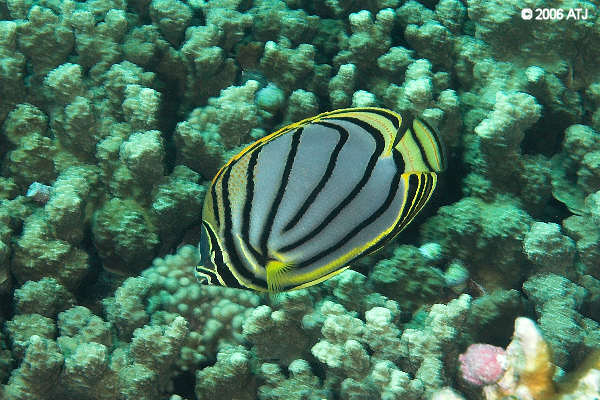
Meyer's butterflyfish, C. meyeri, on Osprey Reef.

Ornate butterflyfish, C. ornatissimus, on Osprey Reef.
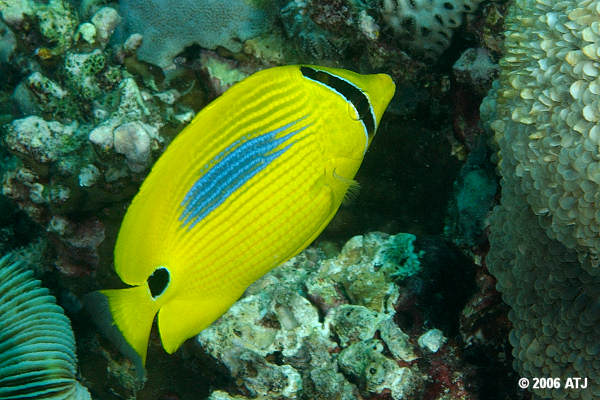
Blue-dash butterflyfish, C. plebeius, on the Great Barrier Reef.
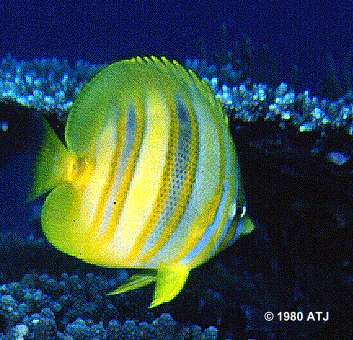
Rainford's butterflyfish, C. rainfordi, on the Great Barrier Reef.
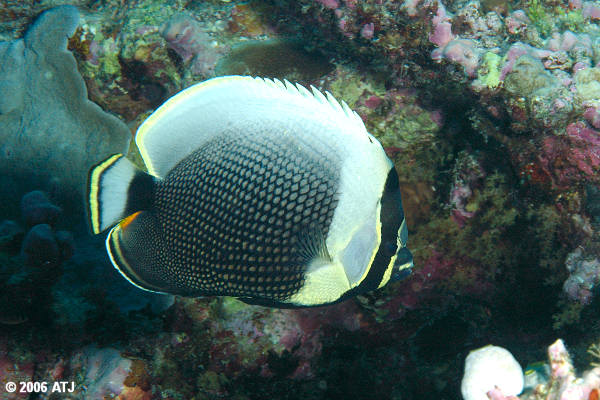
Reticulated butterflyfish, C. reticulatus, on Osprey Reef.
Note also that the copperband butterflyfish, Chelmon rostratus can also be difficult to keep and should best be avoided by novices.

Copperband butterflyfish, Chelmon rostratus, in an aquarium.
Family Pomacanthidae - Angelfish
While most angelfish survive well in captivity, but consideration must be given to the adult size of many species. This applies especially species of Pomacanthus, which can grow to over 30 cm and need very large aquaria.
Some species of angelfish can be difficult to keep and should only be attempted by experienced aquarists, these include:
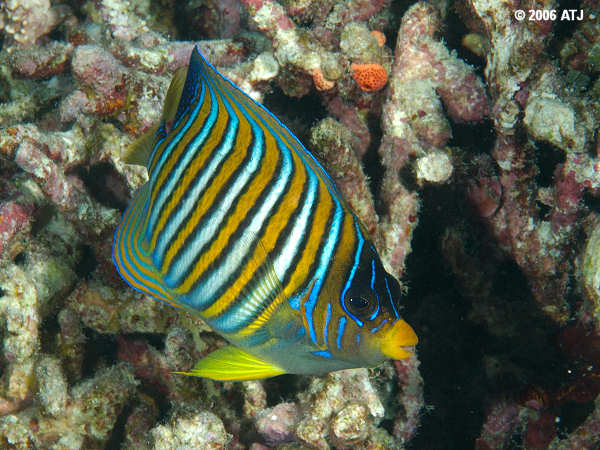
Regal angelfish, Pygoplites diacanthus on the Great Barrier Reef
One group of wrasses, the cleaner wrasses can be difficult to keep. Cleaner wrasses belong to the genus Labroides of which there are 5 species. The most common species seen in aquarium stores is L. dimidiatus, with L. bicolor and L. pectoralis being occasionally offered for sale. All species have a generally poor record of survival in captivity, however, much of this may be due to holding/shipping or to a poor understanding of their husbandry.
Cleaner wrasses get their name because they set up cleaning stations (usually in pairs) in specific areas on the reef and actively clean parasites from fish that visit their establishments. The bulk of the diet of L. dimidiatus is larvae of parasitic gnathid isopods (Grutter, 2000). Many aquarists assume that because these fish feed on parasites in the wild, they will only feed on parasites in the tank and little effort is made to wean them onto prepared foods. Without any parasites in the aquarium, they usually starve to death. Any wild caught fish that is placed in an aquarium will rarely have access to their natural foods and an effort is required to train them to eat prepared foods. Cleaner wrasse are no different and can usually be trained to take prepared foods by first feeding them on live brine shrimp nauplii. This takes effort and for hobbyists who are not prepared to make that effort cleaner wrasses are best avoided.

Common cleaner wrasse, Labroides dimidiatus, in an aquarium
Family Callionymidae - Dragonets
The dragonets are quiet, bottom feeding fish and will generally only eat live food. Most individuals will only fair well in a largish established aquarium with a lot of copepods. This usually excludes aquaria with wrasses which will out compete for the copepods. Dragonets can be trained to feed on prepared foods, but competition with other fish usually prevents them from getting food at feeding time.

Mandarinfish, Synchiropus splendidus, in aquarium.
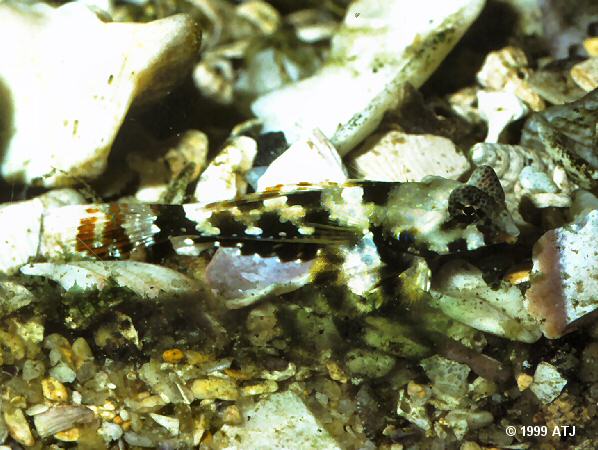
Scooter dragonet, Synchiropus ocellatus, in aquarium.

Psychedelic dragonet, Synchiropus picturatus, in aquarium.
Family Zanclidae - Moorish Idols
There is only one species in this family, Zanclus cornutus, and as a rule this species does not do well in captivity. Some people have success with them, especially if they are kept in a large tank, but the majority die within the first few months. They are best avoided.
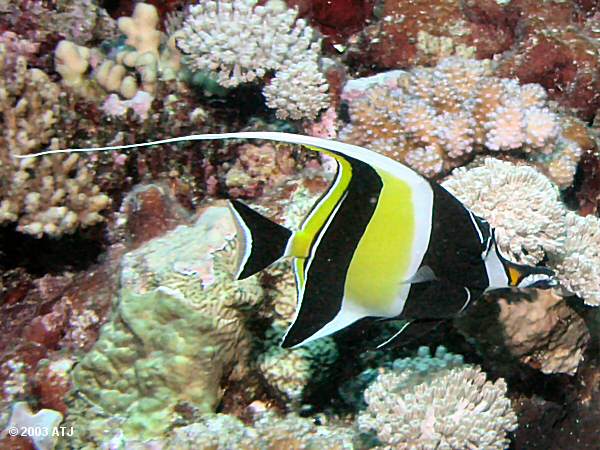
Moorish idol, Zanclus cornutus, on Osprey Reef.
Family Monocanthidae - Leatherjackets and Filefish
The orange-spotted filefish, Oxymonacanthus longirostris is occasionally offered for sale in aquarium stores. These fish feed exclusively on coral polyps, mostly Acropora spp. and don't fair well in captivity. They may do alright in a tank dominated by Acropora, but this would be at the expense of the corals. They are best avoided.

Orange-spotted filefish, Oxymonacanthus longirostris, on Osprey Reef.
Grutter A.S. 2000. Ontogenetic variation in the diet of the cleaner fish Labroides dimidiatus and its ecological consequences. Mar. Ecol. Prog. Ser. 197:241-246.
Ruppert E.E. and Barnes R.D. 1994. Invertebrate Zoology. Saunders College Publishing, Orlando, FL. 1056pp.
Last updated: November 22, 2006